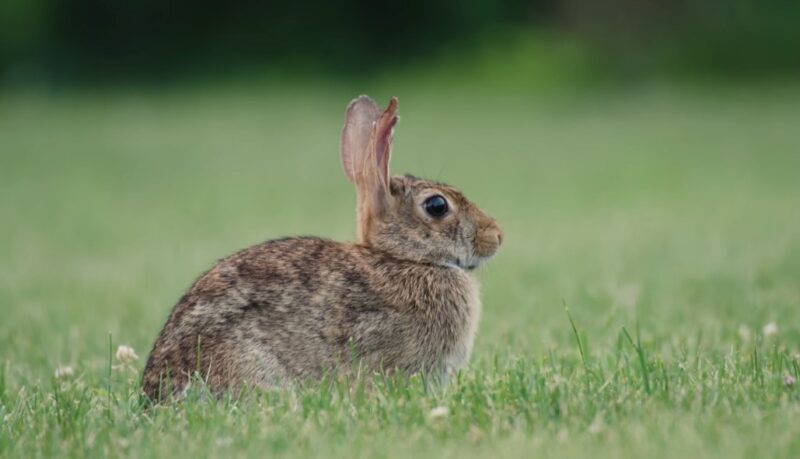Rabbits are fascinating creatures, not just for their playful antics and soft fur but also for how they perceive the world around them.
Their vision is a vital part of their survival toolkit, tailored over millions of years of evolution to suit their specific needs as prey animals.
If you’ve ever wondered how your fluffy friend sees the world, you’re about to find out.
Key Highlights
- Rabbits have a nearly 360-degree field of vision, allowing them to see almost everything around them, except for a small blind spot in front of their nose.
- Their depth perception is limited due to the small overlap between what each eye sees, relying on movement and other cues for gauging distance.
- Rabbits have better vision in dim light, aligning with their crepuscular nature, but their night vision is not as developed due to the absence of a tapetum.
- While the clarity of their vision may be limited, rabbits can likely distinguish between some colors, with blue and green being possible examples.
- The third eyelid, or nictitating membrane, provides protection and moisture for the rabbit’s eyes, highlighting the unique adaptations of rabbit vision for survival.
What Does a Rabbit’s Field of Vision Look Like?
Imagine having eyes on the sides of your head rather than in front. Rabbits have this unique placement of eyes, which grants them a nearly 360-degree field of vision.
Whenever they binky and move around, they can see almost everything around them—above, beside, even slightly behind—without moving their heads.
However, this incredible ability comes with a trade-off: a small blind spot right in front of their nose and under their chin.
That’s why sometimes your rabbit might not notice the treat you’ve placed directly in front of them.
Can Rabbits See in 3D?

Depth perception, or the ability to judge the distance of objects, is crucial for navigating the world.
Humans achieve this by having a large overlap in the field of vision of our eyes, allowing us to see the world in three dimensions.
Rabbits, however, have a very limited overlap—about 30 degrees directly in front of them.
Most of this area is taken up by their blind spot. Despite this limitation, rabbits employ other methods to gauge distance, such as looking for visual cues like size differences and blurring or moving their heads up and down to create parallax, helping them judge how far away something is.
How Clear is a Rabbit’s Vision?
Rabbits might not win any awards for clarity in their vision. Their eyes are designed to focus better on distant objects rather than on those close up.
The muscle responsible for focusing the eye, the ciliary body, is relatively weak in rabbits.
This means their vision might be a bit “grainy” when it comes to details, especially up close.
Rabbits likely recognize you more by your shape and movements than by the details of your face.
Color Vision in Rabbits

The ability of rabbits to see color remains a topic of speculation among scientists. Some behavioral studies suggest that rabbits can distinguish between certain colors like blue and green.
However, their color vision is likely not as rich as humans’, possibly resembling that of dogs, who have fewer color-sensitive cones in their retinas.
Do Rabbits See in the Dark?
Rabbits are crepuscular, meaning they are most active during the twilight hours of dawn and dusk, similar to raccoons.
Their eyes are adapted to moderate light conditions rather than full daylight or complete darkness.
Unlike other nocturnal animals, rabbits lack a tapetum—the part of the eye that enhances night vision by reflecting light.
So, while they can see in dim light, their night vision is not as strong as that of some other animals.
Special Features of Rabbit Eyes

The Third Eyelid – For Protection and Moisture
An interesting aspect of rabbit eyes is the presence of a third eyelid, known as the nictitating membrane.
This feature is not directly related to vision but plays a crucial role in protecting the eye and keeping it moist.
Especially noticeable in albino rabbits, this membrane sweeps across the eye when the rabbit is frightened, and it helps to reduce the need for frequent blinking.
Unanswered Questions and Curiosities

Rabbits exhibit some intriguing behaviors related to their vision. For instance, they often turn sideways to get a better look at something, using one eye.
They also engage in “scanning” behavior, slowly moving their head to the side as if taking in more of their surroundings.
The way rabbits interact with their reflection or recognize each other also raises questions about how their unique vision influences their social interactions.
The Impact of Domestication on Rabbit Vision

While domestication has changed many aspects of rabbit behavior and physiology, their basic visual capabilities remain similar to their wild counterparts.
Domestic rabbits still exhibit behaviors like scanning and sideways viewing, which are tied to their visual adaptations.
However, the environments we provide for our pet rabbits can impact how they use their vision.
Providing a safe, stable environment with plenty of opportunities to explore and interact can help stimulate their visual and cognitive functions, enhancing their overall well-being.
Tips for Rabbit Owners
Understanding your rabbit’s vision can greatly improve how you interact with and care for them. Here are a few tips for rabbit owners:
- Provide Safe Exploration Opportunities: Since rabbits have a wide field of vision but limited depth perception, ensure their play areas are free of hazards they might not see clearly.
- Approach from the Side: Approaching your rabbit from the front might place you in their blind spot. Approaching from the side can be less startling and more within their field of view.
- Use Visual Signals: While rabbits may not see details clearly, they can recognize shapes and movements. Using consistent gestures can help in training and communication.
- Consider Lighting: Since rabbits see best in dim light, avoid exposing them to bright lights directly. Using soft, ambient lighting can make them more comfortable, especially during their active dawn and dusk periods.
FAQs
Final Words
Rabbits have evolved to have a wide field of vision, enabling them to detect threats from almost any direction.
While their depth perception and clarity might not match up to human standards, and their color vision could be limited, these adaptations make perfect sense for a prey animal.
Rabbits may not see the world with the same detail and color as we do, but their vision is precisely tuned to their needs, helping them navigate and survive in their environment.








